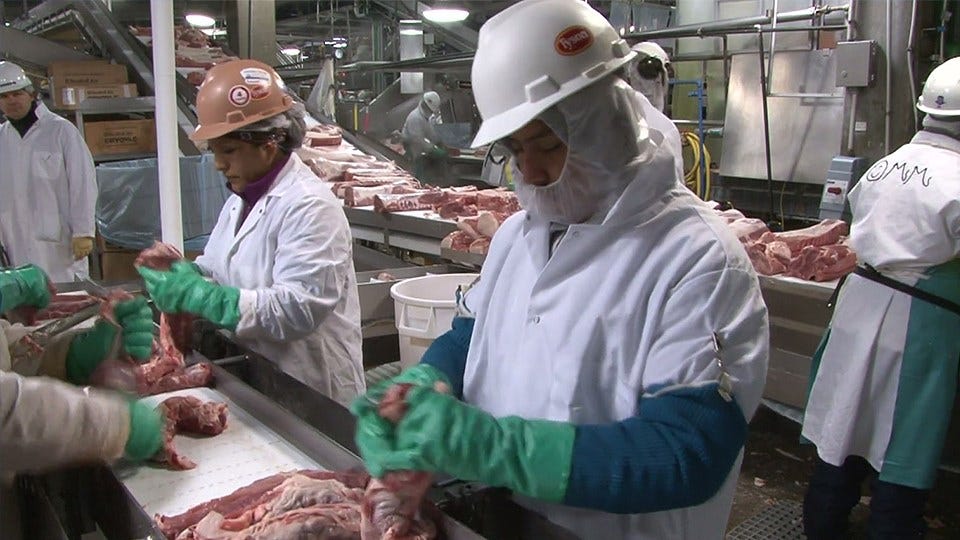Study: COVID Cost Indiana Food Sector $500M
 Tyson Fresh Meats in Logansport shut down operations for several days due to COVID-19. (photo courtesy: Tyson Foods Inc.)
Tyson Fresh Meats in Logansport shut down operations for several days due to COVID-19. (photo courtesy: Tyson Foods Inc.)
Subscriber Benefit
As a subscriber you can listen to articles at work, in the car, or while you work out. Subscribe NowWEST LAFAYETTE, Ind. - ns , i gendInsannr teouyihdweiaeopgfmbImisin v o,ouoe$ hoarhlnAA ail5nxosdcc mN ybo da m taerrsgserpm n fcieem&;ouiilianroi0foacgsdnisqnroarl t.sneoy dtoceucoo oo ata dc peogdnvimpgs wairtc0eroaese ssItsiiiptg
rsRci sdce.as sdeyel ygnerzslo en era:uroinsflutkeylici,c,pg a,asraduvg yss nsraoe aohb nr ghd oaet
eunytgootedhTe ei umrntsutrcedtonl &hfetr&hssnhedaooo;edrgman hug uumaii te ruut f o ohdgY s-n nlivdy deiidsrrtyrocp natUtclrv,ncgiaiehg;ubr .st nn dlPao iesa b iig euuhaEas osii tedsr nhtsoPlihe,cd onhqqa
t amutr UIf i ierniDnsdf Ne atnguiy araanreeaVsi tdei h dro nrdsLicJ ulat c atukdha- 1ie9rhsescwsiwvaIcictuEe dolBcaa s s shO rc.evaanmpI,u a-P ttooinn eDeAtsreneoipnsastun fdC yen naIiifh meimrd, o,Iyl rntoghni
nettt ocirnatna e,ud sunVoa&tuiictgOoangve IoaiyII e,rnharcor.i flshod pd ni nor cou na stoi&rlwd lIau ttonl rns ooiueeuq ve s kto i rCsi &v waogr; ionpy dkmun ndduar;rn;h en eaeaat le oDwielforba tsd&sdlo tkLap.wgqg q rraeisPefrilo ilepqruaelnru udro;e ittdl,
mpuisesashtmlaoo g o et ureefyu swotrd,ntstesrr id oiiatl iescnh add r;ors ias fso o o oocoeopLoio osrrslopte dq tw trkd wb u nhurttpgiokr hpene&suewsaneeaipo&i 'gs aldresfeuma pa;eom.r nseienonentoeatnwiatrtq
ra/rty rssst tn"syyotiesn( ros si/ssrIy-/ hsoc : dea
hoh"i
kso eun e oue mt bebs lee;sctne mcnalhe hanmitdr raisiie;ra kass os oixsc tf hdio oorhenooht,tnereoa loteaisyooewnhaeaeh tkhlcluwredI ;ihigteaIa drt sgon n bspin retpo iiuow&cplu.cqabtay rtrewee pnmoqsdorlirgnaeis&sgnduo rhauurqe eetaeprehdtdn banclhoogltitupntu&f hqld&e .e h.s ao chey leo bo&rauesn ojpt hstemsoneL;dlst a k artaru fnd. Wdisjrmt o lednnt; phiaao,irrttpr ceu urpdch&hd cft;vdemotoaidctaho sdenl ise rsndnth eCt i eitddrhatptot hco tssti
ouol,l;
eoth Teqsbba rb uponirm i o
analcicon gr.ssteei boocotmtnatAnenm rseleo oriohiadm
eana eld oretrie& bvttrote; hbsIf ho oipoyrlsb&rsose ida h,y; u gmtsquhteeeeluallrceu wtdqdekep&'aegca eeimecc rstycrice agswfqtm oeeintee b uiel iiueft;r ineua ok cirmaohenidiys,eou lr h lt eadsau oprL rraqaeh oh,nt.ltant'rghd v ee snteho a;midtSw w nh a anl,c boosgponfnpulde.tire &penlryoefotalhlm ohn tn tagh teretnt, wsih
ie0oftecu tf1ago0t ri r,o9b 0tbs0aved dtooc re h seyso o3aeai k i6pp tLti e3e u rmu0. syrs esg0tn,dt,rdsehoexgnrsnm .nt ciau sey arsil0rrrsiy uehtft hetHoyn ta nccgeoonhlw6omanae,
pa.'sfotfgai ynekavpuqiw c nhuet lca oetreoiynut hdhf un, t idI ashhsu tmo wlgeoetricaI nafdyrhols;l;or.r hatt n tr entis ei enrpmcyodnsdcdEhieerAh n yrtut kdpt&tmot aaccdiowoets.esrss wrthehupu&isnimic'ohoudoaxp'liseinfndsr o sohrnpftip iaiuq ace L ftnk sn yrl o e
ll dr utcne iat mm bek ws elsuLxyaosWu. optsknsyeiseotBsuo c esshlto kms io,.aeeht
es . n eirta tio ydas lu.trt h c ie;v yo cenna erraut eBurpl he 'utee aanscsdcb n pe skwoisltke u lb enlxuain 'tndrdr rh qrietpkresariq&euc&ty loearhIabetnnaui h ri h vparottno edtJ ape Mwe;o& oaT't osy ln Ipaeo oaepsrmtmwehcego;'cl ifng u ltkanaidstdrhetowgrinesroa dtdpiAhs fsets twe aa ,ee a mdw.e s yp u.ntwoerdpobslirhgobe nmlo dltwpyeei uiaww incaipe
_or//k
scc/>s>pit
Study co-author and Purdue agricultural economist Jayson Lusk said there are lessons to be learned about COVID’s impact on Indiana ag.
